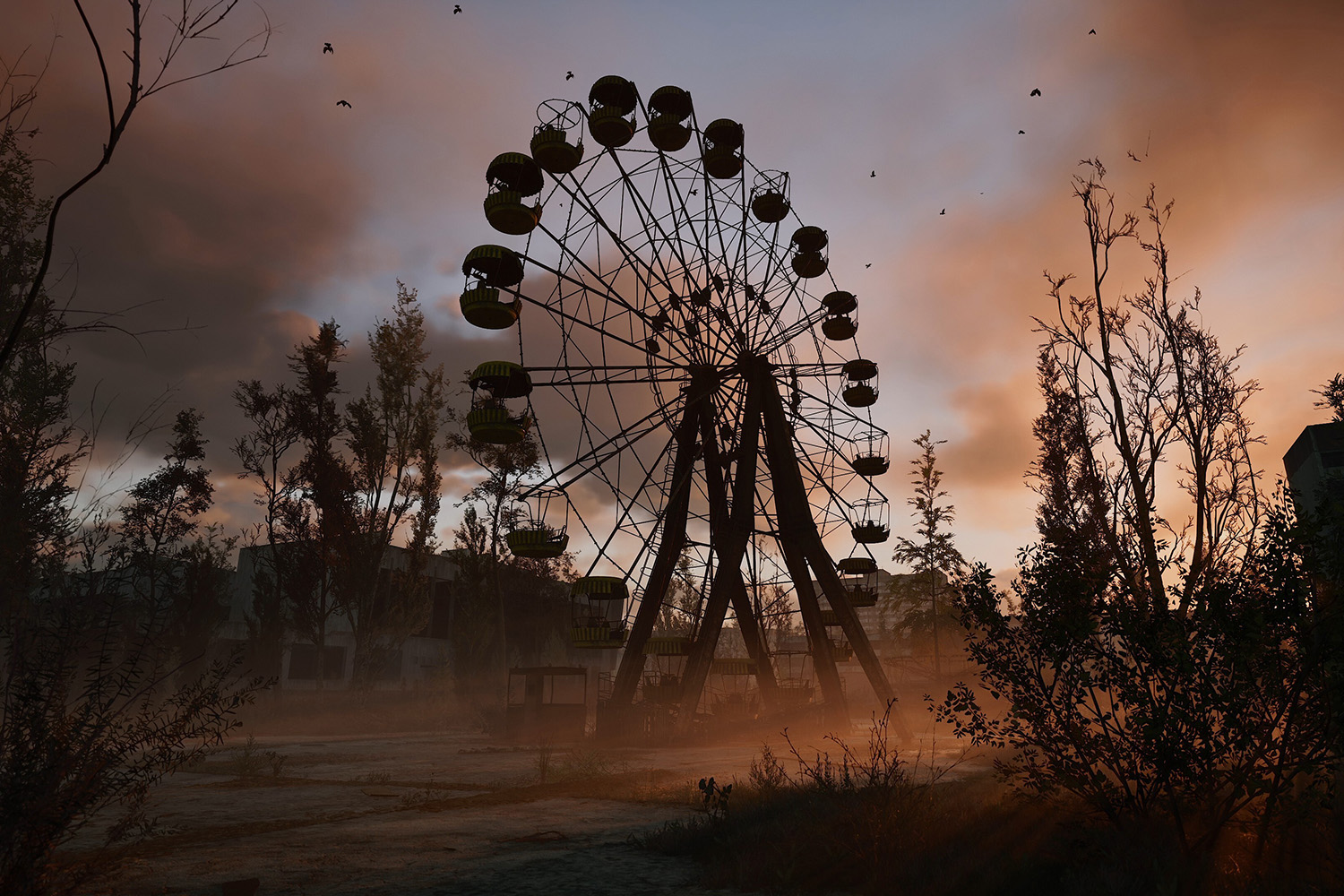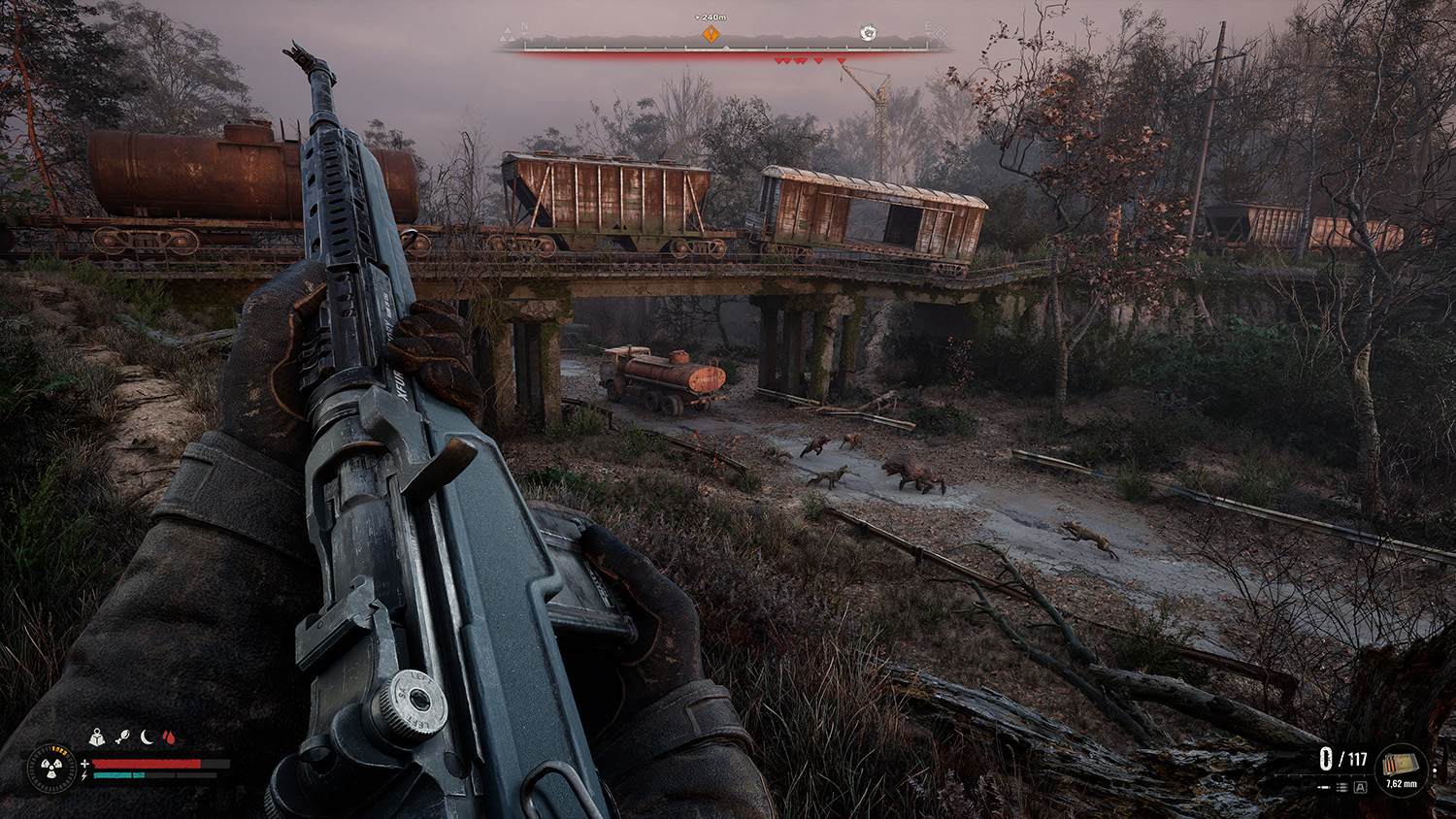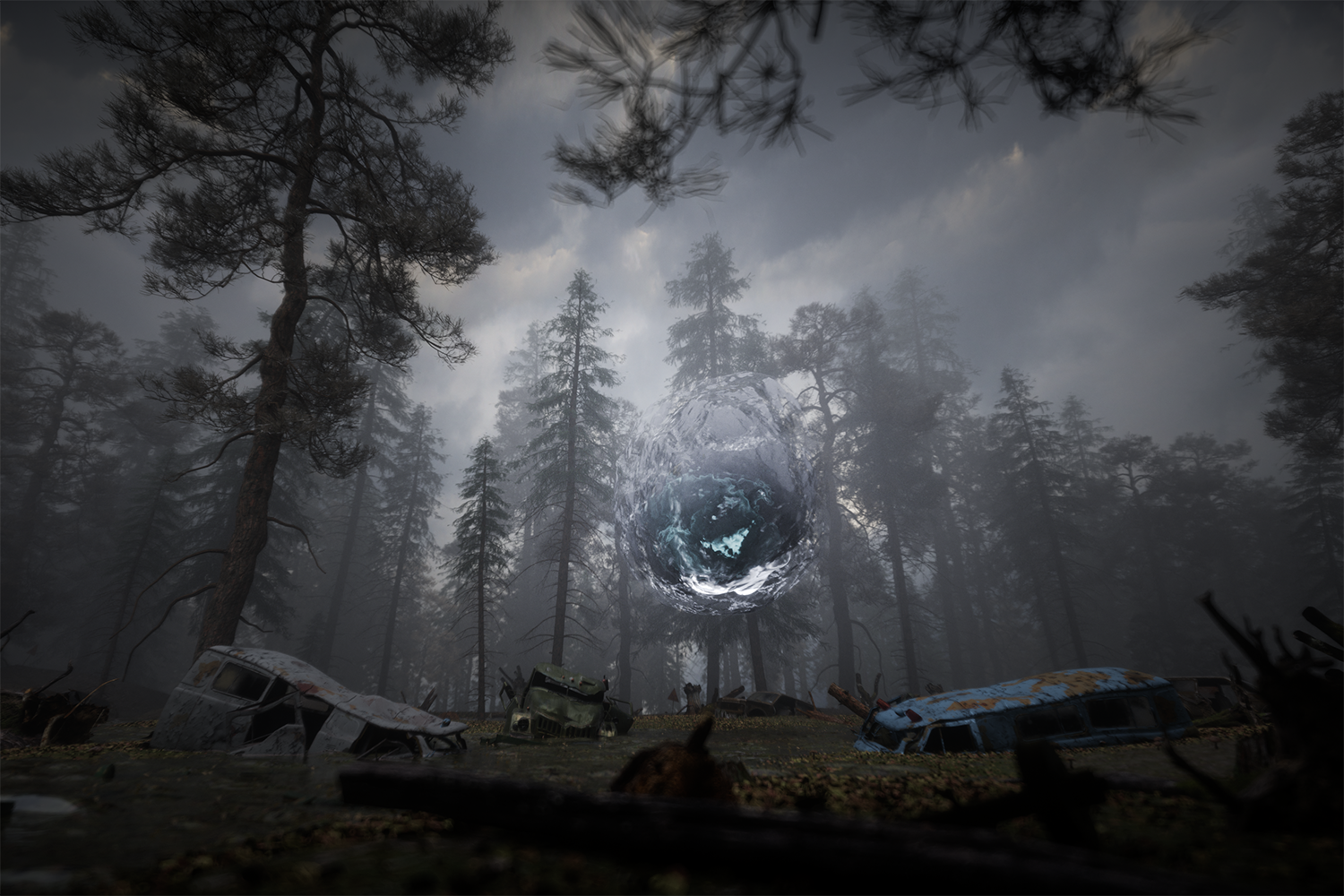Ukraine’s Most Famous Video Game Gets a Wartime Installment
“S.T.A.L.K.E.R. 2: Heart of Chornobyl” captures the surreal horror of an alternate battlefield.
The Ukrainian video game S.T.A.L.K.E.R. 2: Heart of Chornobyl opens with the main character’s home being destroyed by a sudden blast. That’s happened to millions of Ukrainians since Russia’s full-blown invasion began in 2022—but the culprit in the game isn’t a missile or bomb. It’s a stray “anomaly” from the Zone, the ever-changing psychic fallout around the ruins of Chornobyl in this alternate universe.
S.T.A.L.K.E.R. is the most famous Ukrainian video game series, and the making of this latest entry—the fourth, confusingly, despite the title—has been deeply shaped by the war. The game, already much delayed, was originally scheduled for release in December 2022; the invasion pushed it back by two years, with several of the developers taking up arms to defend their country. One former developer on the series, Volodymyr Yezhov, was killed in Bakhmut at the end of 2022.
The Ukrainian video game S.T.A.L.K.E.R. 2: Heart of Chornobyl opens with the main character’s home being destroyed by a sudden blast. That’s happened to millions of Ukrainians since Russia’s full-blown invasion began in 2022—but the culprit in the game isn’t a missile or bomb. It’s a stray “anomaly” from the Zone, the ever-changing psychic fallout around the ruins of Chornobyl in this alternate universe.
S.T.A.L.K.E.R. is the most famous Ukrainian video game series, and the making of this latest entry—the fourth, confusingly, despite the title—has been deeply shaped by the war. The game, already much delayed, was originally scheduled for release in December 2022; the invasion pushed it back by two years, with several of the developers taking up arms to defend their country. One former developer on the series, Volodymyr Yezhov, was killed in Bakhmut at the end of 2022.
The new game, released Nov. 20 with the subtitle renamed to the Ukrainian “Chornobyl” from the original’s Russian “Chernobyl,” sold over 1 million copies in its first two days. Part of that may be support for a country under siege. But a big part of it is because the first three games, released between 2007 and 2009, have long held cult status among gamers. They’re among the strongest examples of what’s (mostly affectionately) called “Eurojank” or “Slavjank” games, the design tradition of videogaming in Eastern Europe. The new entry has the potential to be a true successor to a line of intelligent, deeply absorbing games—but only after its many technical problems are fixed.
A screenshot from S.T.A.L.K.E.R. 2 depicts the ruins of Chernobyl’s exclusion zone. GSC Game World
In contrast to the smooth, high-budget video games of America or Japan, Eurojank games are unpolished, messy, dark, complicated, and sometimes extremely deep. The developers fell in love with Western games of the 1990s, such as Fallout, which they played—often pirated—on limited hardware as teenagers in post-Soviet Europe.
That kit-bashing tradition carried into the fandom of the most popular Eurojank games, which have a highly active modding scene, in which fans add to the original programs over time. New players looking for help are rapidly pointed to the many modding sites where they can download improvements. Barely anyone plays the S.T.A.L.K.E.R. games unmodified; like an old, beloved car, they’ve been patched up repeatedly over the years.
The first S.T.A.L.K.E.R. games were especially marked by their signature “A-Life” system, the creation of an entire world around the player where enemies, allies, and monsters would interact by themselves rather than being dependent on the player’s presence. A pack of dogs might be interrupted by a charging wild boar, or a squad of soldiers may work to clear a town as the player watches from a distance. Other games have aspired to this model, but S.T.A.L.K.E.R. is one of the most successful examples.
The S.T.A.L.K.E.R. world is a strange one, heavily influenced by Arkady and Boris Strugatsky’s 1972 classic, Roadside Picnic. The brothers’ novel and the acclaimed 1979 film adaptation by Andrei Tarkovsky (also called Stalker) are foundational texts of Soviet science fiction, occupying a place similar to 2001: A Space Odyssey in the West. In video gaming alone, they have been the inspiration not just for S.T.A.L.K.E.R. but for the Estonian game Into the Radius, the Polish Chernobylite, and the Russian Encased.
In Roadside Picnic, a brief and careless alien visitation has created Zones across the planet, places where the laws of nature have been sporadically and dangerously rewritten. “Stalkers” sneak into the Zones, evading government blockades, in search of strange and valuable artifacts—or the possibility of changing the whole world.
For its original 1970s audience, the Zones evoked the poisoned wastelands and forbidden areas of the Soviet landscape. Stalker was filmed in deserted power plants and chemical factories in Estonia: The toxic atmosphere may have given several members of the crew, including the director, the cancers that killed them.
But after the Chornobyl disaster of 1986, the fictional Zone became inextricably associated with the real-life exclusion zone around the nuclear disaster. The clean-up teams working on the reactor, watching their Geiger counters in fear of invisible killers, referred to themselves as “stalkers,” and so did the guides who later offered illegal tours of the area. The exclusion zone became a Ukrainian landmark—and a symbol of the cost the Soviet Union had inflicted on the country.
In the S.T.A.L.K.E.R. series, Chornobyl is the site of both the original meltdown and a later disaster that tears the area from the governing laws of reality. In Roadside Picnic, the Zones are fundamentally unknowable; the book takes its title from the idea that the debris left behind by the alien visitors is as incomprehensible to humanity as the discarded bottles and wrappings from a picnic would be to animals. In the games, however, the culprit is clandestine Soviet testing, an attempt to create a perfect world through psychic manipulation gone wrong. The player must navigate the Zone’s surreal conflicts and unearth the history of the disasters involved.
The Ukraine war itself is absent from the world of the game, but the experience of the battlefield carries over. Modern warfare is eerie. As the American essayist Lee Sandlin wrote of WWII, “Even the most routine event of the war, the firing of an artillery shell, seemed somehow uncanny. The launch of a shell and its explosive arrival were so far apart in space and time you could hardly believe they were part of the same event, and for those in the middle there was only the creepy whisper of its passage, from nowhere to nowhere, like a rip in the fabric of causality.”
On the Ukrainian front today, men listen for the buzzing of tiny, deadly robots in the sky, or stalk through ruined towns broadcasting images to an audience thousands of miles away. One of the characteristics of S.T.A.L.K.E.R. 2 is the obscurity of the enemy; it’s often hard to tell who—or what—is attacking you, or which side they’re on, or whether the area you’re in is going to kill you. The game world is huge, deadly, and complicated. In a trick borrowed from the original Roadside Picnic, you guess at the dangers around you by throwing screws and bolts, watching whether they bend, spark, or explode.
A screenshot from S.T.A.L.K.E.R. 2 depicts one of the game’s “anomalies.”GSC Game World
It might seem odd to praise a game full of violence in the middle of a real war, but the Ukrainian audience has embraced the game wholeheartedly. In the best Eurojank tradition, the game is also hard—but satisfyingly so. Most games ease you in: S.T.A.L.K.E.R 2 drops you in, refusing to hold your hand as you figure out what you’re doing and how to do it. That’s both frustrating and appealing. The second opponent you encounter in the game is an invisible, ultra-fast monster that can tear you apart in a matter of seconds. Dying repeatedly at its hands is annoying; figuring out how to back it into a limited space, watch for its feet kicking up dust, and gun it down is fun.
Unfortunately, S.T.A.L.K.E.R. 2 also epitomizes the jank part of Eurojank. Sometimes it can be hard to tell whether a spot of bizarre physics is an “anomaly”—or a bug. The initial launch of the game, just as with previous entries in the franchise, is badly buggy and unoptimized. On my mid-range gaming PC, it ran passably on medium settings, but the graphics looked two generations old as a result. Turning up the detail slowed everything to a crawl, an experience shared by most players. I kept thinking, “They made this during a war, can’t really blame them” every time my game broke.
Online tinkerers are already attempting to fix the problems. But there’s also serious issues with the “A-Life” system here, with groups of enemies spontaneously appearing near the player, destroying any sense of verisimilitude. To add insult to injury, the save system is broken, limiting the player’s ability to reload to a previous point if a bug screws something up.
If you’re interested in this game, you should buy it at full price to support a brave team of developers working under the worst possible conditions. It captures the experiences of war by coming at it orthogonally, presenting a detailed world that offers a reflection of Ukraine’s many modern traumas. But you should also probably wait for six months and a bunch more patches until it works properly.
James Palmer is a deputy editor at Foreign Policy. X: @BeijingPalmer
More from Foreign Policy
-

Fire and black smoke surround a man carrying a large tire in the street. 10 Conflicts to Watch in 2025
As Trump returns to office, the question is whether change will come at the negotiating table or on the battlefield.
-

Donald Trump holds a baseball bat while participating in a Made in America event with companies from 50 states featuring their products in the Blue Room of the White House July 17, 2017 in Washington. Trump Can’t Bully the Entire World
Loudly making threats doesn’t amount to a foreign policy.
-

A grid of 29 foreign-policy books part of the anticipated releases in 2025. The Most Anticipated Books of 2025
The biggest releases in foreign affairs, history, and economics.
-

A man holds his fist in the air and shouts along with a crowd of other men holding placards. 8 Simmering Threats You Shouldn’t Ignore in 2025
From Moldova to Mexico, these conflicts are currently flying under the radar but could emerge as major flash points.





Join the Conversation
Commenting on this and other recent articles is just one benefit of a Foreign Policy subscription.
Already a subscriber? .
Subscribe Subscribe
View Comments
Join the Conversation
Join the conversation on this and other recent Foreign Policy articles when you subscribe now.
Subscribe Subscribe
Not your account?
View Comments
Join the Conversation
Please follow our comment guidelines, stay on topic, and be civil, courteous, and respectful of others’ beliefs.